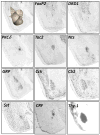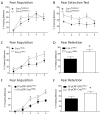Mouse models of fear-related disorders: Cell-type-specific manipulations in amygdala
- PMID: 26102004
- PMCID: PMC4685028
- DOI: 10.1016/j.neuroscience.2015.06.019
Mouse models of fear-related disorders: Cell-type-specific manipulations in amygdala
Abstract
Fear conditioning is a model system used to study threat responses, fear memory and their dysregulation in a variety of organisms. Newly developed tools such as optogenetics, Cre recombinase and DREADD technologies have allowed researchers to manipulate anatomically or molecularly defined cell subtypes with a high degree of temporal control and determine the effect of this manipulation on behavior. These targeted molecular techniques have opened up a new appreciation for the critical contributions different subpopulations of cells make to fear behavior and potentially to treatment of fear and anxiety disorders. Here we review progress to date across a variety of techniques to understand fear-related behavior through the manipulation of different cell subtypes within the amygdala.
Keywords: amygdala; cell subtype manipulation; fear conditioning; fear extinction.
Copyright © 2015 IBRO. Published by Elsevier Ltd. All rights reserved.
Figures




Similar articles
-
Grin1 receptor deletion within CRF neurons enhances fear memory.PLoS One. 2014 Oct 23;9(10):e111009. doi: 10.1371/journal.pone.0111009. eCollection 2014. PLoS One. 2014. PMID: 25340785 Free PMC article.
-
The role of NCAM in auditory fear conditioning and its modulation by stress: a focus on the amygdala.Genes Brain Behav. 2010 Jun 1;9(4):353-64. doi: 10.1111/j.1601-183X.2010.00563.x. Epub 2010 Jan 4. Genes Brain Behav. 2010. PMID: 20059553
-
Impaired fear extinction in mice lacking protease nexin-1.Eur J Neurosci. 2010 Jun;31(11):2033-42. doi: 10.1111/j.1460-9568.2010.07221.x. Epub 2010 May 24. Eur J Neurosci. 2010. PMID: 20529116
-
Brain sites involved in fear memory reconsolidation and extinction of rodents.Neurosci Biobehav Rev. 2015 Jun;53:160-90. doi: 10.1016/j.neubiorev.2015.04.003. Epub 2015 Apr 14. Neurosci Biobehav Rev. 2015. PMID: 25887284 Review.
-
Neurobiology of anxiety disorders and implications for treatment.Mt Sinai J Med. 2006 Nov;73(7):941-9. Mt Sinai J Med. 2006. PMID: 17195879 Review.
Cited by
-
Lacosamide intake during pregnancy increases the incidence of foetal malformations and symptoms associated with schizophrenia in the offspring of mice.Sci Rep. 2020 May 6;10(1):7615. doi: 10.1038/s41598-020-64626-9. Sci Rep. 2020. PMID: 32376856 Free PMC article.
-
Involvement of CRFR1 in the Basolateral Amygdala in the Immediate Fear Extinction Deficit.eNeuro. 2016 Nov 2;3(5):ENEURO.0084-16.2016. doi: 10.1523/ENEURO.0084-16.2016. eCollection 2016 Sep-Oct. eNeuro. 2016. PMID: 27844053 Free PMC article.
-
Panic Anxiety in Humans with Bilateral Amygdala Lesions: Pharmacological Induction via Cardiorespiratory Interoceptive Pathways.J Neurosci. 2016 Mar 23;36(12):3559-66. doi: 10.1523/JNEUROSCI.4109-15.2016. J Neurosci. 2016. PMID: 27013684 Free PMC article.
-
Serine Racemase and D-serine in the Amygdala Are Dynamically Involved in Fear Learning.Biol Psychiatry. 2018 Feb 1;83(3):273-283. doi: 10.1016/j.biopsych.2017.08.012. Epub 2017 Aug 26. Biol Psychiatry. 2018. PMID: 29025687 Free PMC article.
-
Multidimensional processing in the amygdala.Nat Rev Neurosci. 2020 Oct;21(10):565-575. doi: 10.1038/s41583-020-0350-y. Epub 2020 Aug 24. Nat Rev Neurosci. 2020. PMID: 32839565 Free PMC article. Review.
References
-
- Pavlov IP. In: Conditioned reflexes : an investigation of the physiological activity of the cerebral cortex. Anrep GV, editor. London: Oxford University Press, Humphrey Milford; 1927.
-
- Bolles RC. Species-specific defense reactions and avoidance learning. Psychological Review. 1970;77(1):32–48. doi: 10.1037/h0028589. First Author & Affiliation: Bolles, Robert C. - DOI
-
- Blanchard RJ, Blanchard DC. Crouching as an index of fear. Journal of comparative and physiological psychology. 1969;67(3):370–5. Epub 1969/03/01. - PubMed
-
- Fanselow MS. Conditioned and unconditional components of post-shock freezing. The Pavlovian journal of biological science. 1980;15(4):177–82. Epub 1980/10/01. - PubMed
-
- Abiri D, Douglas CE, Calakos KC, Barbayannis G, Roberts A, Bauer EP. Fear extinction learning can be impaired or enhanced by modulation of the CRF system in the basolateral nucleus of the amygdala. Behav Brain Res. 2014;271:234–9. doi: 10.1016/j.bbr.2014.06.021. Epub 2014/06/20. - DOI - PMC - PubMed
Publication types
MeSH terms
Grants and funding
LinkOut - more resources
Full Text Sources
Other Literature Sources
Medical
Molecular Biology Databases

